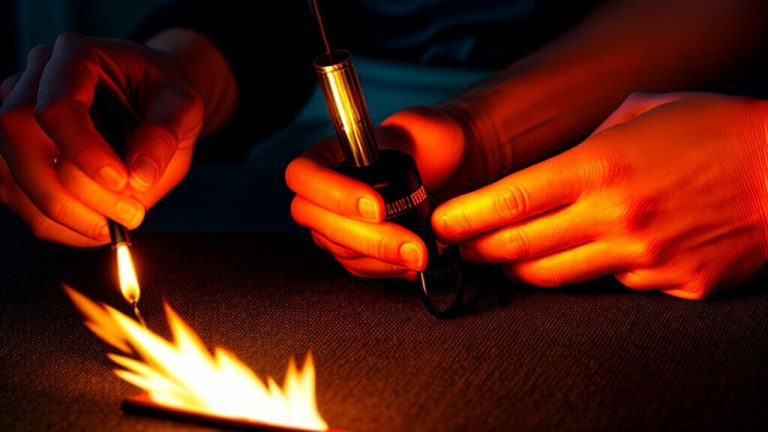Are you struggling with a torch lighter that won’t stay lit? It can be frustrating and inconvenient, especially when you need it the most. A torch lighter is handy for many activities, including lighting a cigar, starting a campfire, or soldering. That’s why it’s essential to ensure it’s functioning correctly, and that’s where we come in. This article will provide expert tips on troubleshooting and fixing a torch lighter that won’t stay lit and make your skin lighter.
Key Takeaways
- A torch lighter that won’t stay lit can be frustrating and inconvenient.
- Possible reasons for a torch lighter not staying lit include a clogged nozzle, low fuel, air pockets, or a faulty ignition mechanism.
- To troubleshoot and fix your torch lighter, check the fuel level, clear the nozzle, purge air pockets, clean the ignition mechanism, adjust the flame height, or service/replace the ignition mechanism.
- Maintaining your torch lighter regularly can ensure optimal performance.
- If faced with advanced issues, seek professional assistance.
Understanding the Possible Reasons
There are several reasons why a torch lighter may have trouble staying lit. Understanding these reasons can help in addressing the issue properly. Here are some of the common causes of a torch lighter not staying lit:
| Cause | Description |
|---|---|
| Clogged nozzle | A clogged nozzle can prevent the torch lighter from producing a consistent, steady flame. |
| Low fuel | The fuel level of a torch lighter must be sufficient to produce a flame. If the fuel is low, the lighter may not stay lit. |
| Air pockets | Air pockets in the fuel system can disrupt fuel flow, resulting in a weak or intermittent flame. |
| Faulty ignition mechanism | If the ignition mechanism is dirty or not functioning properly, the torch lighter may not ignite or stay lit. |
Identifying the root cause can help determine the appropriate steps to fix the problem.
Checking for Fuel Level and Quality
Before troubleshooting a torch lighter that won’t stay lit, it’s important to check the fuel level. A depleted fuel tank can cause problems with the torch flame’s consistency and strength. Refill the tank with high-quality butane fuel if the fuel level is low or empty. Please do not use other fuel types; they can damage the lighter and affect its performance.
When checking the fuel level, pay attention to the fuel’s quality. Using impure or low-quality fuel can cause problems with the torch lighter’s ignition mechanism and nozzle. Avoid using old or contaminated fuel, leading to clogged nozzles or poor flame quality. Always use fresh, high-quality butane fuel to ensure optimal performance.
Clearing the Nozzle
The nozzle may be clogged with debris or residue if your torch light won’t stay lit. Clearing the nozzle is a simple troubleshooting step that can save you from replacing the entire lighter.
To clear the nozzle, you’ll need a small pin or needle to unclog any debris obstructing the torch flame. First, turn off your lighter and allow it to cool completely. Then, insert the pin or needle into the nozzle and carefully wiggle it around to dislodge any debris. Avoid using anything too sharp or forceful that could cause damage to the nozzle.
Once you’ve cleared the nozzle, test the lighter again to see if the flame stays lit. If the problem persists, move on to the next troubleshooting step.
Purging Air Pockets
If your torch lighter won’t stay lit, it could be due to the presence of air pockets. These pockets may form when the lighter is tilted or turned upside down. To purge the air from the fuel system, follow these steps:
- Bleed the lighter by turning the fuel adjustment to the lowest setting.
- Hold the lighter upside down and press the ignition button several times until the flame gets smaller and eventually extinguishes.
- Turn off the lighter and wait a few minutes for the butane to settle in the tank.
- Hold the lighter upright and turn the fuel adjustment to the highest setting.
- Press the ignition button to light the flame and adjust the fuel setting to your desired height.
If purging the air pockets does not resolve the issue of your torch lighter not staying lit, try some of the other troubleshooting tips outlined in this article.
Cleaning the Ignition Mechanism
A dirty or faulty ignition mechanism can cause your torch lighter to have issues staying lit. Regular maintenance is essential to ensure optimal performance of the ignition system.
To begin, make sure the lighter is fully emptied of fuel. Disconnect the fuel supply by removing the valve stem, and be careful not to damage the O-ring.
Wipe down the ignition mechanism using a soft-bristled brush or a clean cloth to remove any debris or residue affecting its functionality. Use a small pin or needle to clear any hard-to-reach areas gently.
After cleaning, reassemble the ignition mechanism and fill the lighter with high-quality butane fuel. Test the lighter to ensure it sparks and ignites appropriately before using it.
Note: If the ignition mechanism is severely damaged or still not functioning correctly, it may need professional servicing or replacement.
Adjusting the Flame Height
Adjusting the flame height is essential in troubleshooting a torch lighter that won’t stay lit. A too-low or too-high flame can cause issues with ignition and consistency.
First, to adjust the flame height, ensure that the lighter is ignited and the flame is steady. If you have a lighter with a built-in flame height dial, turn it clockwise to increase the flame height or counter-clockwise to decrease it. If your lighter has no dial, you can adjust the flame height by using a small screwdriver on the flame adjustment mechanism.
Make minor adjustments and test the flame height until you find the sweet spot. It’s essential to note that the flame height will vary based on altitude and temperature, so you may need to adjust periodically.
Servicing or Replacing the Ignition Mechanism
If you have attempted all the previous troubleshooting steps, but your torch lighter still won’t stay lit, it may need professional servicing or replacement of the ignition mechanism. This is especially true if you notice any visible damage to the ignition mechanism or if it fails to spark.
When seeking professional help, choose a reputable repair service that can identify the root cause of the issue and provide a lasting solution. A qualified technician can assess the ignition mechanism and determine whether it needs repair or replacement.
It’s worth noting that attempting to repair or replace the ignition mechanism yourself can be dangerous and may even void the lighter’s warranty. Play it safe and leave it to the professionals.
Maintaining Your Torch Lighter
Maintaining your torch lighter is essential to ensure optimal performance and longevity. Follow these simple tips to keep your torch lighter in top condition:
- Clean the lighter regularly: Dirt, dust, and debris can clog the nozzle, reducing functionality. Use a pin or needle to clear any obstructions, and regularly wipe it clean with a soft cloth.
- Refill with high-quality butane: Use only high-quality butane fuel to avoid clogging and prolong the life of your torch lighter. Cheaper butane can contain impurities that can affect the performance of your lighter.
- Store it properly: Keep your torch lighter in a cool, dry place away from direct sunlight or heat when not in use. This will protect the lighter from damage and extend its lifespan.
Remember to avoid accidents and perform all maintenance tasks in a well-ventilated area, away from open flames or heat sources.
Troubleshooting Advanced Issues
While many torch lighter issues can be resolved with simple troubleshooting, some advanced problems may require professional assistance. Here are a few scenarios where seeking professional help may be necessary:
- Leaking fuel: If you notice fuel leaking from your torch lighter, do not attempt to fix it yourself. This can be extremely dangerous and may cause harm. Seek the help of a professional to address the issue safely.
- Valve damage: If your torch lighter’s valve is damaged or broken, it may not be able to function properly. A professional can inspect and replace the valve if necessary.
- Technical malfunctions: If your torch lighter has a complex technical issue, such as a malfunction in the ignition system, it may require professional repair or replacement.
While seeking professional help for advanced issues may incur a cost, it is important to prioritize your safety and the functionality of your torch lighter.
Conclusion
In summary, a torch lighter that won’t stay lit can be frustrating but is a common issue that can be resolved with troubleshooting. The first step is understanding the possible reasons for the problem, including a clogged nozzle, low fuel, air pockets, or a faulty ignition mechanism.
Checking the fuel level and quality is crucial, and using high-quality butane fuel can make a significant difference. Clearing the nozzle or purging air pockets can also help troubleshoot the issue.
Cleaning the ignition mechanism and adjusting the flame height can also improve the performance of the lighter. However, if the problem persists, it may require professional servicing or replacement of the ignition mechanism.
Regular maintenance, such as cleaning the lighter, refilling it with high-quality butane, and storing it correctly, can prevent future issues. It is best to seek professional assistance if faced with advanced issues or technical malfunctions.
We hope these expert tips have helped troubleshoot and resolve the issue of a torch lighter that won’t stay lit. A fully functional torch lighter is convenient and makes tasks such as lighting candles or firing a grill much more manageable. Remember to try these tips before seeking professional help and regularly maintain your lighter for optimal performance.

I’m Alfred Davis, and I’m all about lighters. Hailing from the great state of Texas, USA, I’ve cultivated a deep passion for these fascinating gadgets. With years of hands-on experience and a burning curiosity (pun intended), I’ve become an expert in all things related to lighters.
My journey with lighters began as a hobby and quickly became a full-blown obsession. I’ve explored the diverse world of lighters inside and out, from classic Zippo designs to modern plasma arc models. I’ve tested, tinkered with, and even collected rare pieces while learning the intricate mechanics and unique histories behind each one.
Through my writing, I aim to share my knowledge, insights, and reviews to help you make informed decisions about choosing the perfect lighter. Whether you’re a seasoned collector or just looking for a reliable fire source, I’ve got you covered. Join me in unraveling the fascinating realm of lighters right here at LightersInfo, where ignition meets expertise.
Alfred Davis

